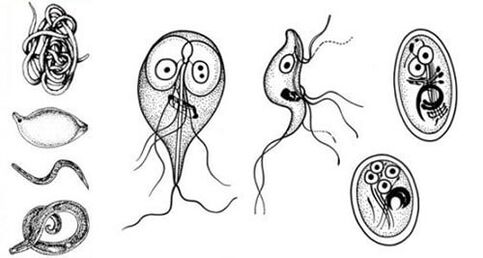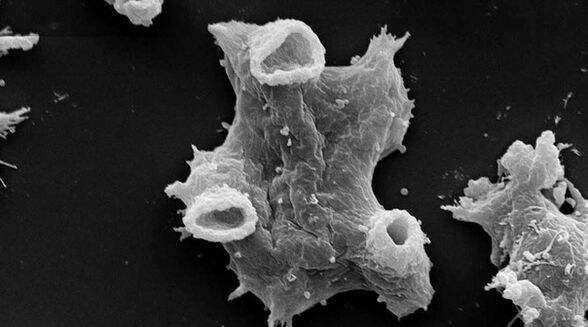Usually refers to parasitic single-celled microorganisms that are persistent parasites in the human body and feed on its "juice". They have nothing to do with worms, but some single-celled parasites can reach large sizes.

They are completely independent organisms, although they have lost their digestive vacuoles due to their lifestyle.
Parasite classes
Representatives of different organisms can be classified as follows:
- Sarcode- Negleria and amoeba.
- spore- Toxoplasma Plasmodium.
- branch- balantidium
- Rod- Leishmania, Trichomonas, Trypanosomes and Giardia.
These creatures were among the first simple creatures to appear on the planet. Their basic structure and working function can cause the development of deadly diseases. The list includes common representatives of protozoan parasites, but there are many more.
Impact on the body
Although these parasites are called protozoa, they have a very bad effect on the human body, causing dangerous diseases.
Sarcode
amoeba dysentery (Entamoedahistory).The parasite is most common in hot countries. One feature is the absence of skeleton and shell formation. She has legs for movement. It can form cysts in the human body.
Usually causes amoebiasis when the intestinal wall is affected. A person has loose, bloody stools. Diagnosing such a type of amoeba is quite difficult. She is a very dangerous parasite.
Negleria Fowler.Humans are the intermediate host. The place of localization of the parasite is usually the brain.
Causes amoebic encephalitis, often fatal.
Rod
Trichomonas (Trichmonasvagina).The disease occurs in men with almost no symptoms, only in the form of transport. In women, it manifests with obvious signs of inflammation: profuse discharge with an unpleasant odor, itching, and pain in the lower abdomen.
As a rule, this simplest parasite is transmitted sexually, but it also occurs through family contact. Infected women can pass it on to their babies during childbirth.
Giardia.These microorganisms live in the gastrointestinal tract. Effects on the body include cystic transport for many years, but the disease progresses to a mild form. Rarely, it becomes chronic. By the way, they are not afraid of harmful substances and ultraviolet radiation.
spore
Leishmania (Leishaniaspp).This species colonizes most human organs and eventually destroys them. Causes a serious disease - visceral leishmaniasis. In their habitat, an ulcer with holes is formed, which constantly rots. It is difficult to treat and often requires surgery.
Plasmodium malaria.It is localized in plasma, red blood cells and liver cells. The worst part is that these simple organisms destroy red blood cells. Leads to tropical malaria and many days. May cause serious damage to the kidneys and disrupt the nervous system.
Toxoplasma.It affects the lymph nodes and small intestine. Toxoplasmosis often develops, which is very dangerous for pregnant women. In the early stages of the infection, it resembles a viral infection.
branch
Intestinal balantidia (Balantidiumcoli).Usually affects the large intestine, especially the cecum. This is a fairly large single-celled organism that is easily introduced into the bloodstream.
They do not cause much harm to the body, but can cause ulcers in the intestines.
Symptoms and diseases caused by protozoa
Currently, a number of pathogens have been identified that cause the following diseases:
- Giardiasis.
- Malaria.
- Leishmaniasis disease.
- Trichomoniasis infection.
- Cryptosporidiosis fungal disease.
- Balantidiasis.
amoebic dysentery
Infection occurs through food and household items.
Symptoms appear with the mild stage of the disease:
- Bloating.
- Abdominal pain.
- Constipation is replaced by diarrhea.
Average severity of the disease process:
- Symptoms increase within 10 days.
- Weakness and loss of appetite.
- Mucus with blood.
- Abundant manure.
When the disease becomes chronic, the amount of weight decreases completely.
Diseases caused by this parasite:
- Peritonitis.
- Amoebic appendicitis.
- Dysentery.
- Lung and liver abscesses.
- Extremely rare amoebic hepatitis and brain abscess.
- Skin infection with the development of ulcers and erosions.
With the lightning-fast progression of the disease, it can even lead to death in debilitated people.
Naegleria fowleri (Naegleria fowleri)

You can get this parasite while swimming in a pond, as well as by air.
The disease always begins with acute manifestations:
- Loss of smell and taste.
- Headache and weakness.
- Nausea and want to vomit.
- Loss of coordination of movements.
- Pulmonary edema may develop.
- Hallucinations and convulsions.
The disease is difficult to diagnose and often ends with the death of the patient.
Negleria causes the following pathologies:
- Amoebic encephalitis.
- Scalp fungal disease.
- Destroy the brain.
- A person usually falls into a coma.
Infection is often fatal.
lamblia
The disease occurs without obvious symptoms. Infection is transmitted through unwashed fruit and through dirty hands.
Typical symptoms:
- Increased salivation.
- Abdominal discomfort.
- Loss of appetite and nausea.
Sometimes passing green, foamy, pungent stools.
Diseases causing: giardiasis and various intestinal dysfunctions.
Leishmania
Mosquito infestation is caused by mosquitoes.
It has serious symptoms:
- Enlarged spleen and liver.
- Rising temperatures.
- Nurturing conditions.
- Weak and pale skin.
- Bleeding on the skin.
- Problems with the functioning of the heart.
- Anemia and severe weight loss.
Sometimes edema and pneumonia may be involved.
This parasite leads to cachexia, decreased muscle tone, impotence, and heart failure.
Trichomonas
Infection occurs with indiscriminate hygiene items. Symptoms are almost absent, but occasionally appear.
For men:
Discomfort while urinating.
- There is blood in the semen.
- White discharge.
For women:cervicitis and vaginitis.
Infection is very dangerous for pregnant women, as it can cause premature birth.
Malarial Plasmodium
Mosquito bites lead to infection.
Plasmodium vivax.Symptoms depend on the stage of the disease:
- Chills up to 3 hours - muscle and joint pain, liver pain.
- Fever for about 12 hours - temperature up to 40 degrees, pressure drop, shortness of breath and rapid heart rate.
- Intense sweating phase - sharp drop in temperature accompanied by perspiration, muscle weakness and low blood pressure.
Malaria that lasts three days can develop and may go away on its own. There may be an enlarged spleen, anemia, and sometimes jaundice.
Plasmodium malaria.There are fevers in the morning and evening. In addition, there are signs of malaria for three days. Can cause nephrotic syndrome, which is difficult to treat.
Plasmodium ovale.The fever only comes in the evening. The disease progresses quite easily, but the liver may be slightly enlarged.
Toxoplasma
The way of infection is quite widespread. You can become infected from half-baked meat, dirty produce, blood transfusions, and cuts in the skin. By the way, the infection of a pregnant woman is often passed on to the fetus.
When there is an acute form of the disease, the following symptoms appear:
- The liver and spleen were markedly enlarged.
- Signs of jaundice.
- Skin rash.
- Typical symptoms of meningitis and encephalitis.
- Lymph nodes are enlarged.
In the chronic form:
- Long time high temperature.
- Muscle and bone pain.
- In women, the menstrual cycle is interrupted.
- Headache and irritability.
In addition, there may be problems with the thyroid gland and adrenal insufficiency.
Parasitic infections of this class threaten the emergence of many diseases:
- Body weakness.
- Toxic parasitic infection.
- epilepsy.
- Retinal inflammation.
- hepatorenal syndrome.
Rarely, but sclerosis of the lymph nodes does occur.
Intestinal balantidia
You can catch parasites through unboiled water, dirty hands and fruit.
Signs of infection:
- Persistent diarrhea with pus and blood.
- Abdominal pain syndrome.
Balantidia leads to the development of peritonitis, visceral abscess and perforation of the intestinal wall.
Inference
Protozoa infection is very similar to viral infection. By definition, they are not considered worms, although they cause great harm to human health.
Protozoan infection can be fatal, so when typical symptoms appear, seek medical attention immediately. Self-medication is strictly prohibited.






































